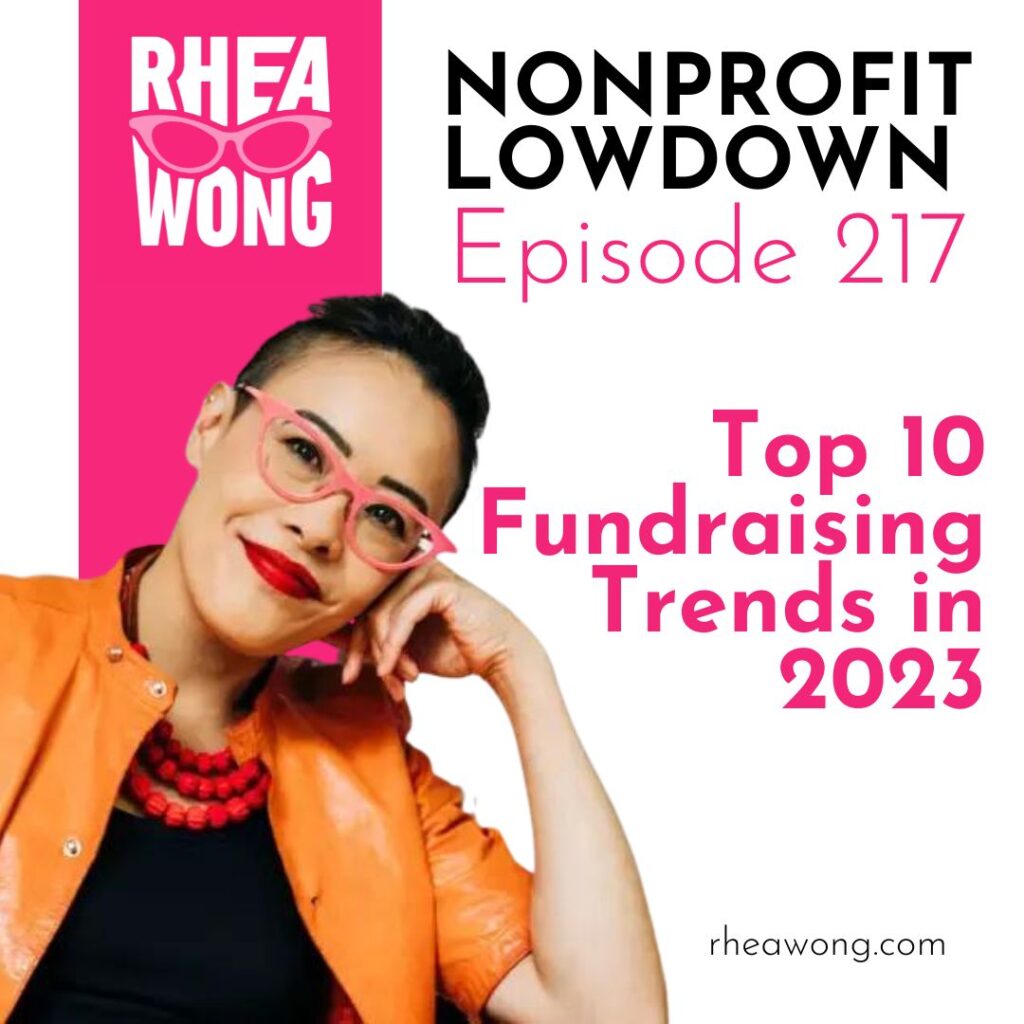We are in our very last week of 2022 and I think we can all agree, it has been a lot. After the upheaval of the pandemic, I feel like life is back to normal-ish. And what I’ve been hearing from a lot of you is that you are feeling really tired and so that you find some time at the end of the year to enjoy it with your friends and family.
Here’s a fun way to wrap up our year, I have decided to put on my prognostication hat and discuss some of the Top 10 trends that I see for fundraising in 2023, listen now!
Have a happy, healthy, safe and restful, joyful time and I will see you in 2023! Take care 🐶 Happy holidays 🎄
Episode Transcript
RHEA WONG 00:05
Welcome to Nonprofit Lowdown. I’m your host, Rhea Wong. Hey, podcast listeners! It’s Rhea Wong with you once again with Nonprofit Lowdown. As this publishes, we are in our very last week of 2022. And I think we can all agree, it has been a lot.
RHEA WONG 00:22
After the upheaval of the pandemic, I feel like life is back to normal-ish. And what I’ve been hearing from a lot of you is that you are feeling really tired and so that you find some time at the end of the year to enjoy it with your friends and family.
RHEA WONG 00:39
I also really want to thank you for being loyal listeners to Nonprofit Lowdown. It’s such a labor of love. I’ve enjoyed every minute of it. I keep learning and growing, and I hope that you do as well.
RHEA WONG 00:50
If there’s ever anything that you want to hear more about, always feel free to send me an email at hello@rheawong.com Always happy to try to cover episodes that you all want to hear about.
RHEA WONG 01:00
So, as a fun way to wrap up our year, I have decided to put on my prognostication hat and discuss some of the top 10 trends that I see for fundraising in 2023. So buckle up. Let’s go. Number one, in no particular order, I think we are going to continue to see the use of DAFs or donor-advised funds.
RHEA WONG 01:26
These are funds that people can use in order to fund nonprofit organizations in large chunks of money. They’re often managed by community foundations or large institutions like fidelity. I think the rise of the DAFs is here to stay.
RHEA WONG 01:42
And I think the people that are going to be able to make the best use of it are the ones that are actively out there creating relationships with folks that have significant wealth and capacity. I know that sounds really stupid but obviously, that’s true.
RHEA WONG 01:58
But I think what we’ll continue to see is people using DAFs as a way to give to their favorite nonprofits or philanthropy.
RHEA WONG 02:07
What I think will be a little bit difficult is that there is some opacity between the decision-makers who give out the money and the people who are actively seeking the money.
RHEA WONG 02:18
So my advice would be to really start to reach out and create relationships with the program officers at your local Community Foundation because they’re the ones that are in the business of connecting nonprofits and donors.
RHEA WONG 02:31
Otherwise, there’s really no way to research DAFs. There’s really no way to know who has DAFs, I’m hoping that we will also continue to see more transparency and some better policies around how much has to be dispersed from DAFs. But I don’t think that’s a trend that’s going anywhere anytime soon.
RHEA WONG 02:51
Number two, I think we will continue to see the rise of crypto donations. So as younger people are acquiring wealth and younger tech people are getting involved in crypto, I think the smart nonprofit will be the ones that develop some kind of strategy around crypto donations.
RHEA WONG 03:11
People who love crypto, love crypto, and I think to be able to catch fire there and be able to leverage the strong community passion for crypto will work for a nonprofit.
RHEA WONG 03:26
For those of you who are crypto-curious, I have an episode coming out soon with Alexis Miller of Endaoment where we talk all about crypto and crypto donations. It’s very, very fun stuff.
RHEA WONG 03:41
Okay, number three, I think we’re going to see younger donors. So right now, we’re in the middle of the biggest wealth transfer in the world. I think younger donors, and I’m talking primarily about Gen X and Millennial donors tend to make decisions much more quicker.
RHEA WONG 03:58
They tend not to follow the same sort of traditional cultivation cycle that we’ve seen with boomers and the greatest generation. As a result, think that they will tend to be more trust-based and more impact focused.
RHEA WONG 04:11
They want greater transparency. On that note, though, I think that we’re also going to see, so prognostication number four will see a further fractionalization of a donor base. So the more we can know our donors, both their demographic and their psychographic outlook, the better we are going to be able to target them.
RHEA WONG 04:34
In a world of social media and a million channels and a million options, I think we have absolutely lost our attention span. We’re in the attention economy. And so the messages that are going to cut through the noise will be the ones that are hyper-specific and hyper-personalized.
RHEA WONG 04:55
On that note, number five, I think there’s an ever-shrinking attention span of our donor base. And so personalization, and telling stories that truly resonate with the worldview, and the perspective and psychographic view of your donor is going to be key, which again, speaks to why it’s important to know your donor very, very intimately.
RHEA WONG 05:16
But not that way. You know what I mean. Number six, because of a younger donor base, they are digital natives. And they expect a certain level of accessibility when it comes to the website.
RHEA WONG 05:29
So I think nonprofits really need to focus on the user experience on their website. And many donors, in fact, are self-cultivating.
RHEA WONG 05:40
And so what that means is, having information available on the website, through social media, or through other means, to help donors decide to donate is going to be key because oftentimes, younger donors will not want to have a conversation.
RHEA WONG 05:53
They’re not going to want to meet you for coffee. They’re not going to want to go through the longer intensive cultivation process. So the more that you can put really compelling, easily accessible, attractive information on your website to help people make decisions to hit that donate button, the better off you’re going to be.
RHEA WONG 06:18
We’re past the point where we use the website as a way to entice our donors to have further conversations. We’re now at a point where the website is the whole meal. Number seven, I think that we will continue to see that trend of fewer but larger donors.
RHEA WONG 06:41
So if you look at numbers from the last couple of years via Giving USA, we’re seeing a large percentage of gifts overall given by individuals. But within that, a larger number of gifts are being given by a smaller number of donors.
RHEA WONG 06:56
And so this obviously speaks to the need for a major gift program and a way to identify potential major donors for your organization. Number eight, the way to cut through the noise will be branding, marketing, and storytelling.
RHEA WONG 07:12
Those that tell the best stories will win. And those that have the best-looking assets will win. Again, because of the fact that we’re in the attention economy, it’s going to be so difficult to cut through the noise. And so the ones who tell stories well, the ones that tell stories that hit the heart and make people feel something are the ones that are going to survive.
RHEA WONG 07:36
Number nine, stewardship will continue to be important. Historically, as a sector, we’re not that great at stewardship. What I would like to encourage everyone to think about are the strategies that are zigging while other people are zagging.
RHEA WONG 07:51
So what does that look like? It looks like perhaps doing things that don’t scale like personal written notes. I know a lot of nonprofits are moving towards the automation of thank-you notes as a first step.
RHEA WONG 08:02
I don’t think that there’s anything wrong with automation, but at the core of how we’re going to keep our drivers giving is to make them feel special to us. On that note, too. I think looking at different vehicles, such as text communication, or video communication, something that is a little bit different hitting on that novelty is going to get the attention of your donors.
RHEA WONG 08:24
Finally, number 10. This is not new, but I think it bears repeating is consistent communication is going to help. So in the profit world, we might call this a nurture sequence. Your fans and your donor should be hearing from you on some regular cadence.
RHEA WONG 08:41
They should know what to expect from you. And the things that you send to them should provide value. It’s not just about asking for money. It’s about sharing stories of impact. It’s about sharing stories of the folks that you serve.
RHEA WONG 08:53
It’s about even sharing stories of your staff members and what it’s like to work at your organization. Consistency is key to being able to share stories on a regular basis to keep people connected to the mission. The other piece, too, is to consider LinkedIn.
RHEA WONG
I think LinkedIn is probably the most underutilized, the radar, media platform out there. And also, because the content on LinkedIn is relatively thin compared to the other social media platforms.
RHEA WONG 09:23
You get a lot of play. And it has the added benefit of being the social media platform that a lot of wealthier individuals and professionals are on. I think the smart nonprofits are going to be the ones that have a smart LinkedIn strategy.
RHEA WONG 09:37
The other thing is to consider other platforms that are less saturated, so TikTok is an example. So anyway, those are my top 10 prognostications for 2023. Let’s go through them one more time.
RHEA WONG 09:50
Number one, continued use of DAFs, number two, the rise of crypto donations, number three younger donors that are more trust base impact focused and really want transparency. Number four, for the fractionalization of your donor base.
RHEA WONG 10:03
Number five, ever-shrinking attention spans and focuses on personalization. Number six, having a really good user experience, focusing on instant gratification, gamification, and anything that helps your donors to self-cultivate and self-solicit.
RHEA WONG 10:23
Number seven, fewer donors, larger gifts. Number eight, branding, marketing, and storytelling will cut through the noise. Number nine, stewardship, zig while other people zag. Think about underutilized platforms like text messaging, video, and number ten, consistent communication via social.
RHEA WONG 10:42
And really, I’m very bullish on LinkedIn. So consider a LinkedIn strategy. So hopefully that was helpful. We will be able to see if any of my prognostications come to fruition next year.
RHEA WONG 10:54
But in the meantime, happy holidays to you and yours, have a happy, healthy, safe and restful, joyful time and I will see you in 2023. Take care!
—
Support this podcast: https://anchor.fm/nonprofitlowdown/support



